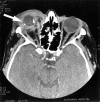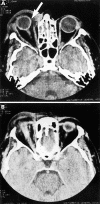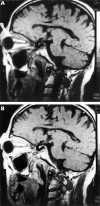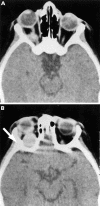Radiological and clinicopathological features of orbital xanthogranuloma
- PMID: 10684833
- PMCID: PMC1723398
- DOI: 10.1136/bjo.84.3.251
Radiological and clinicopathological features of orbital xanthogranuloma
Abstract
Background: Orbital xanthogranuloma, a diagnosis confirmed histologically, occurs rarely in adults and children. With its characteristic macroscopic appearance the adult form may be associated with a spectrum of biochemical and haematological abnormalities including lymphoproliferative malignancies.
Method: The clinicopathological features and imaging appearances on computed tomography and magnetic resonance imaging of this condition are described in eight adults and a child.
Results: Radiological evidence of proptosis was present in seven patients. In all nine patients an abnormal infiltrative soft tissue mass was seen, with increased fat in six cases. All patients had associated enlargement of extraocular muscles suggestive of infiltration and five had lacrimal gland involvement. Encasement of the optic nerve, bone destruction, and intracranial extension was present only in the child with juvenile xanthogranuloma. Haematological and/or biochemical abnormalities were detected in seven patients and seven patients had other systemic diseases which were considered to have an immune basis. One patient subsequently developed non-Hodgkin's lymphoma.
Conclusion: The investigation and management of orbital xanthogranulomas requires a multidisciplinary approach even though the diagnosis may be suspected clinically. Imaging delineates the extent of disease and involvement of local structures and may influence the differential diagnosis. The juvenile form may be more locally aggressive, causing bone destruction with consequent intracranial extension.
Figures








References
Publication types
MeSH terms
LinkOut - more resources
Full Text Sources
